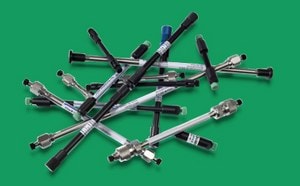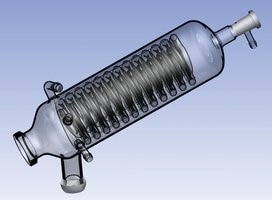小分子高效液相色谱

小分子分析
小分子是指分子量较低(通常小于 900 道尔顿)的化合物。小分子的一些常见例子包括氨基酸、脂类、糖类、脂肪酸、生物碱等。
小分子的分离方法多种多样,包括 High Performance liquid chromatography (HPLC), liquid chromatography (LC), gas chromatography (GC)、thin-layer chromatography (TLC) 和毛细管电泳 (CE)。此外,还可选择核磁共振光谱法(NMR)或质谱法(MS)进行鉴定。近年来,液相色谱-质谱联用技术(LC-MS)已成为鉴定小分子化合物的关键技术。
小分子的高效液相色谱 (HPLC)、超高效液相色谱 (UHPLC) 或液相色谱-质谱 (LC-MS) 分析能否获得最佳结果,取决于选择最合适的固定相和流动相条件。分析物的化学成分是选择最合适的色谱柱化学成分的关键。速度、样品基质和化合物数量等其他方面决定了固定相的最佳基质材料。
特色类别
小分子的高效液相色谱
小分子的高效液相色谱分析通常采用反相分离模式。亲水相互作用色谱(HILIC)和正相色谱也适用于极性化合物的分离,其中亲水相互作用色谱是首选方法。离子化合物的分离可采用离子交换分离模式,无机阴离子或阳离子的分离也可采用离子色谱法。
高效液相色谱柱由全孔二氧化硅颗粒、表面多孔二氧化硅颗粒、聚合物颗粒填充,或由 monolithic silica 棒作为固定相。此外,还使用氧化铝、氧化锆颗粒和碳颗粒。用于小分子分离的固定相材料的典型孔径范围为 60 Å - 160 Å。对于高效液相色谱法,固定相的典型粒径范围为 3 µm 至 5 µm,而对于超高效液相色谱法,则使用更小的粒径,通常为 2 µm 或更小。固定相上可附加不同的色谱柱选择性(改性)。C18 烷基链是反相 (RP) 色谱中最常用的色谱柱化学结构。不过,其他改性,如 C30、C8、苯基、五氟苯基和各种极性更强的改性,以及具有离子交换或手性特性的改性,也能分离几乎所有可溶于液体的化合物。RP-HPLC 的流动相通常由水性缓冲液或水以及乙腈或甲醇等水溶性有机溶剂组成。
高效液相色谱样品制备
复杂且富含基质的样品,如食品、饮料、化妆品、生物样品和富含基质的药物制剂(如膏霜、糖浆),需要高效的样品制备方案来去除不需要的成分,并选择性地萃取所关注的分析物。在超高效液相色谱(UHPLC)中,颗粒尺寸为 2 微米或以下,如果固定相的颗粒尺寸非常小,则这一点至关重要。常见的样品制备方法有液液萃取、固相萃取 (SPE),对于生物样品,还可采用过滤旁的蛋白质沉淀法。除了对目标化合物进行选择性洗脱和预浓缩外,样品制备的主要目的是保护高效液相色谱固定相不受样品基质堵塞的影响。基于 monolithic silica可以在很大程度上耐受基质,与微粒柱相比,所需的样品制备要少得多。衍生化将分子转化为其衍生物,以提高高效液相色谱的灵敏度或色谱保留率。具有理想物理和化学特性的化学试剂可用于所需的衍生化。
相关文章
- Chromolith® HPLC and UHPLC columns are made from monolithic silica with a bimodal pore structure using sol-gel technology.
- Review the effects of efficiency (plate number), retention, and selectivity factors on HPLC resolution. See how factors relate to particle and column characteristics via the HPLC resolution equation.
- Supel™ Carbon LC U/HPLC columns facilitate high-temperature and high-pressure separation of polar or charged compounds.
- LC-MS sensitivity optimization tips minimize contaminations, enhancing detection limits and spectrum clarity for accurate analysis.
- This study demonstrates the impact of various mobile phase modifiers on the separation; formate modifiers outperform acetate in terms of MS signals (or sensitivity) and chromatographic resolution.
- 查看全部 (178)
相关协议
- Chromolith® HPLC and UHPLC columns are made from monolithic silica with a bimodal pore structure using sol-gel technology.
- Review the effects of efficiency (plate number), retention, and selectivity factors on HPLC resolution. See how factors relate to particle and column characteristics via the HPLC resolution equation.
- Supel™ Carbon LC U/HPLC columns facilitate high-temperature and high-pressure separation of polar or charged compounds.
- LC-MS sensitivity optimization tips minimize contaminations, enhancing detection limits and spectrum clarity for accurate analysis.
- This study demonstrates the impact of various mobile phase modifiers on the separation; formate modifiers outperform acetate in terms of MS signals (or sensitivity) and chromatographic resolution.
- 查看全部 (89)
查找更多文章和协议
我们能提供哪些帮助
如有任何问题,请提交客户支持请求
或与我们的客户服务团队联系:
发送电子邮件custserv@sial.com
或致电 +1 (800) 244-1173
额外支持
- Chromatogram Search
Use the Chromatogram Search to identify unknown compounds in your sample.
- 计算器与应用_缓冲液计算器_HPLC方法转换计算器-默克生命科学
默克该工具箱包括用于化学、生命科学、材料科学等方面的科学研究工具和资源。
- Customer Support Request
Customer support including help with orders, products, accounts, and website technical issues.
- FAQ
Explore our Frequently Asked Questions for answers to commonly asked questions about our products and services.
如要继续阅读,请登录或创建帐户。
暂无帐户?



